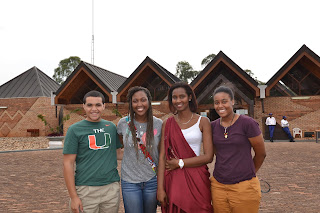We traveled to East Africa to learn, listen, and collect stories so that we may better know the beauty of the bright continent. In both Tanzania and Rwanda, people welcomed us so warmly that we were able, in three short weeks, to accomplish these goals--and more. As we depart, and as I write this final blog entry, I believe these 13 students are allies of Africa. In our closing "gratitude for the group," students identified, universally, the value of our mature and open discussions. In and outside of class, this group watched, reflected, deconstructed, and sought continuing revelation. Part of the reason we achieved this level of intellectual depth is because of the high level of investment each and every student brought to the work. With joy and tireless curiosity, students started and closed each day fully present for the journey. As trip leaders, we held a high bar and maintained an intense schedule. No traveler talked to family (including me:) for more than 10-15 minutes, no one utilized technology except to blog, and no one watched any media that did not relate to the purpose of our trip. Our two movie nights were both documentaries about Rwanda--including one magical night when filmmaker Eric Kabera opened his studio to our group for a private showing of Intore. It was, as the kids might say, "a lot." I cannot imagine sharing this magical journey with a more committed group of students, and I am grateful to them for their strength, beauty, individuality, and goodness. I am also grateful beyond belief for Lauren and Jess; the three of us make a great team and traveled as sisters (without the fighting:) We all go in peace--made better by being here, and with a deep appreciation for this amazing opportunity.
"I am grateful to Rwanda for..."
Afia: how welcoming people have been.
Clara: being able to prove so many stereotypes wrong.
Cole: effectively using truth and reconciliation to recover.
Ellen: teaching so much and opening my mind.
Ethan: self-reliance and thinking outside the box.
Gabby: engulfing me with a thousand hills.
Jess: everyone was so honored to have us and we were so honored to be here.
Hannah from South Africa: "for the best trip ever!"
Julia: everyone who had us for a visit or over for dinner. It is hard to understand the extent to which people made us feel like family and feel so close to everyone.
Kenny: for teaching us to be partners.
Laura: the people who have been so welcoming. everywhere we went, we were treated so kindly, like part of a family.
Lauren: confirming my belief in love and optimism.
Michael: the sense of community I have felt while here.
Nathaniel: to chance to breathe this air and live on this land. I am also grateful for the warmth and hospitality. In DC, when people wave, I do not always wave back, but here people always wave back.
Shields: for showing us how an African nation can rise above and even lead the way.
Tatiyana: teaching me the importance of family, peace writ large, and, most importantly, the importance of inner peace.
 |
| following our last class in the Highland Suites |
A Poem for Rwanda
By: Tatiyana Lyn Lewis
Broken shards equal broken dreams
Scattered evenly across the galaxy
The stars glittering with the tales of those forgotten
voices
That shrieked with terror and agony
As they met their fate
And those that are left let rivers flow through their eyes
Each drop that creates a stream
Tells the story of those who have ascended
And acts as a way to forever memorialize their lives
Their visions
Their hopes and dreams
They all had purpose
They were all a gift from God
Taken too soon by a seed the devil planted in the hearts of
the weak and lost
Possessed they were and thrown into a deep slumber
And once the deed was done
They were awoken and left broken in two
The devil in red receded into the background
Laughing at the work he had done
Thinking he had destroyed a people and a land
But they have risen from the deep and dank abyss
Kicking dirt into the face of the one in red
Each step they take a flower grows through the cracks
Until a bountiful jungle springs
No evil lasts forever
Find peace and optimism with follow
Nothing of darkness will prosper
in a land that God has
breathed upon.



















































